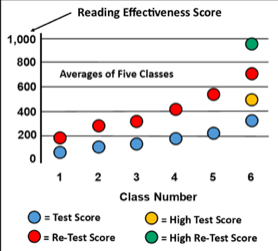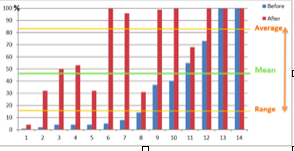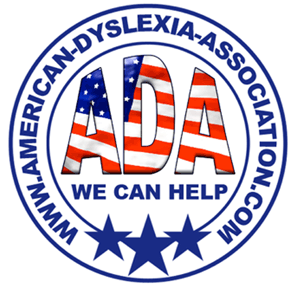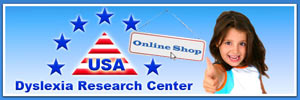Dyslexia Is Done
For over 100 years, dyslexia has had a good run. It’s caused heartache, misery and frustration for millions. That’s over now. A fifth independent study has once again proven that dyslexics can become better readers than non-dyslexics. It takes between 20 and 40 hours of practice with a method called “Eye-Hop.”
The Eye-Hop exercises are fun and easy to do. Through progressive levels, people move from processing one word at a time to reading 5 to 8 words at a time. This is all done with high comprehension. Amazingly, those with the worse phonological processing achieve the greatest percentage increase in their reading abilities. This appears to be due to the ability to process so much information in one glance. Like predictive text on a smart phone, the more information provided the more certain it is of the word you’re typing.
Eye-Hop is an element of the SuperReading Program. This course, developed in 1995, has always produced these results. The difference today is that SuperReading is now available 100% online. Nearly a year was spent creating compatible online testing, which is rigorous and accurate. Resources were also spent to perfect an online App which converts ordinary text into the Eye-Hop format almost instantly. This means that age-appropriate material of interest can be used to fulfil the hours required to overcome dyslexia.
The online SuperReading course is easy to understand and apply. Any parent or guardian can read about a tool, or watch a 3-minute video, and explain it to a child in a minute or two. Coaching is available, though not required. Every child graduating the SuperReading Program has become the best reader and learner in their school in 60 days or less. In the case of some dyslexics, it has taken closer to 90 days.
Skill levels are measured by “Reading Effectiveness” (RE) with standardized tests. RE is reading speed multiplied by comprehension/recall (expressed as a percentage). For example, a person reading at 200 words per minute (wpm), able to recall 50% of what they read, would have an RE of 100, or 200 x .5 = 100. A person reading at 150wpm with 50% accurate recall would have an RE of 75, or 150 x .5 = 75. In plain English, RE tells us how fast we read and what we have to show for the time spent. The SuperReading Program guarantees to at least double the baseline RE scores of any person. With the online testing, this is now a much “cleaner” process than from paper. All scores are computed, graphed out and tracked in a secure database.
SuperReading was developed in Silicon Valley, in the mid-1990s. One of the first companies to bring in the Program was Apple Computer. After 5 weeks, their Global Response Team was able to reduce 28 hours of reading each week down to 5 hours. They also reported that their engineers did a better job reading incoming emails, as their “Negative Response Rate” (NRR) dropped by 85%. The NRR was end-users complaining that the engineers did not understand their email. The first identified dyslexic to enter the Program was from the legal department at Hewlett-Packard in 1996. In a group of 25 engineers and managers, Nancy started off with the lowest RE scores in that group. 35 days later she had the highest RE scores. This would become a trend in the years to follow.
From 1996 to 2005, hundreds of dyslexic readers came through the SuperReading Program, did their Eye-Hop exercises, and became brilliant readers. In 1996 these engineers asked to have the Program for their children. Some companies held family classes after hours. Those children quickly became the best readers in their school. Many of them were dyslexic, others had ADHD, ADD and other learning challenges. No condition or label seemed to make any difference. They all became great readers and progressed from dreading having to read to loving it. When asked why they felt that way, most replied that it was no longer a chore, or torture. It was easy and felt like fun. Apparently, children do not run away from fun- they move toward it. Combined with memory tools and stress-free study techniques, these students thrived. After a major exam, one student commented that the memory tools made it easier than cheating! Other students agreed.
In 2006, I moved to the UK. There I met Dr. R. Cooper, one of the UK’s leading authorities on dyslexia. At first, he dismissed the results, believing those people were not truly dyslexic; that they only thought they were. As a person who sat on the board when the UK defined dyslexia, he had been teaching teachers how to help dyslexics for 16 years. Dr. Cooper politely dismissed me. Nearly a year later, while teaching law students at the London City Law School, I had two dyslexic students take the course. They had papers from bonified Assessors of Need proclaiming them as dyslexic. They more than tripled their initial RE scores and wrote glowing testimonials. I sent the documents and comments to Dr. Cooper, who invited me to London South Bank University to run a course for a group of dyslexic students and adults. Dr. Cooper was, in his words, “astounded at the results.” The last class was very emotional- lots of tears from people who had just finished a book for the first time in their life. Some were in their 40s and 50s. We ran a second course, this time with a control group. We got the same results. 84% of the dyslexics ended up with higher RE scores than a group of non-dyslexic university professors! In future studies, they would be compared to their non-dyslexic peers, and 100% would end up with higher RE scores. Since 2009, the UK government has funded SuperReading for all dyslexic university students in the UK.
The Italians have translated SuperReading into Italian and are taking it through their university system. They have seen equal success in a high school and in their dyslexia centers. You can view their latest published study. The other studies can be accessed from our website.
The SuperReading Program is available now, at https://superreading.com along with the unique Eye-Hop exercises. Dyslexia has had its day. Now you can have yours.
Ron Cole
The Reading & Learning Coach
Soaring Students, Delighted Parents,
Turned-On Teachers
Category: Dyslexia









